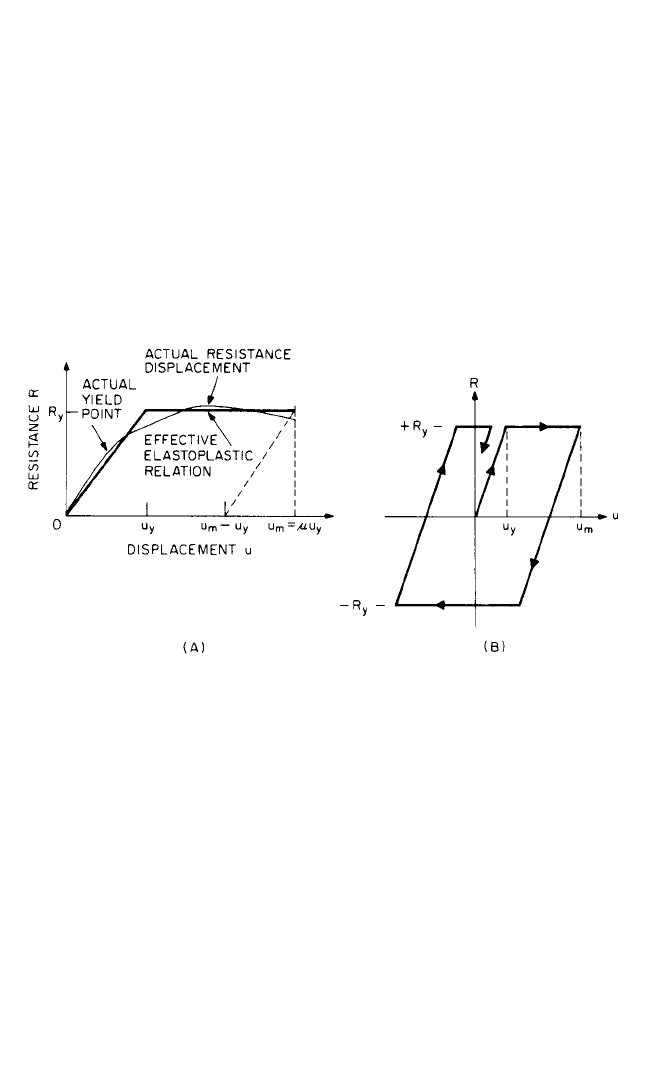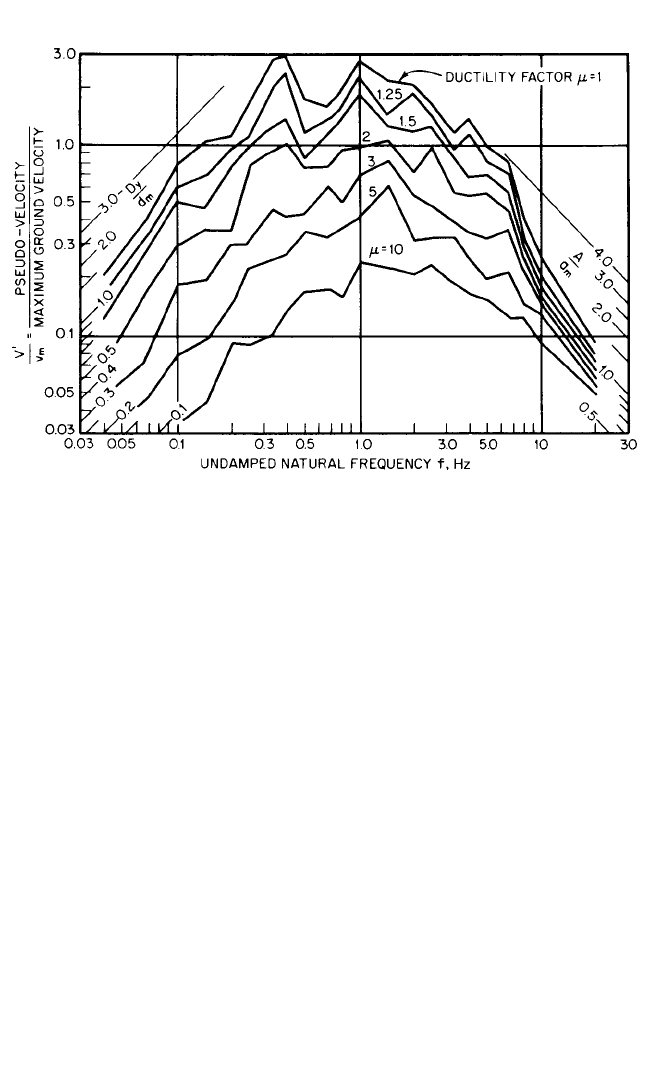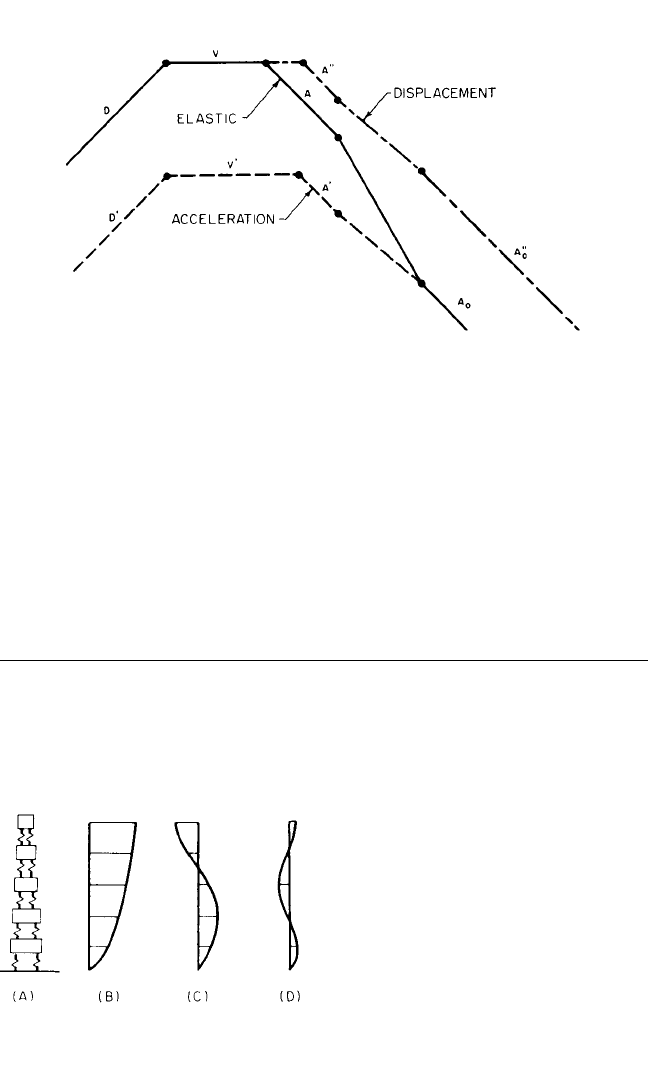Harris C.M., Piersol A.G. Harris Shock and vibration handbook
Подождите немного. Документ загружается.


RESPONSE SPECTRA FOR INELASTIC SYSTEMS
It is convenient to consider an elastoplastic resistance-displacement relation be-
cause one can draw response spectra for such a relation in generally the same way
as the spectra were drawn for elastic conditions. A simple resistance-displacement
relationship for a spring is shown by the light line in Fig. 24.10A, where the yield
point is indicated, with a curved relationship showing a rise to a maximum resist-
ance and then a decay to a point of maximum useful limit or failure at a displace-
ment u
m
; an equivalent elastoplastic resistance curve is shown by the heavy line. A
similar elastoplastic resistance function, more indicative of seismic response, is
shown in Fig. 24.10B. The ductility factor µ is defined as the ratio between the max-
imum permissible or useful displacement to the yield displacement for the effective
curve in both cases.
The ductility factors for various types of construction depend on the use of the
building, the hazard involved in its failure (assumed acceptable risk), the material
used, the framing or layout of the structure, and above all on the method of con-
struction and the details of fabrication of joints and connections. A discussion of
these topics is given in Refs. 1c, 10, and 11. Figure 24.11 shows acceleration spectra
for elastoplastic systems having 2 percent of critical damping that were subjected to
the El Centro, 1940, earthquake. Here the symbol D
y
represents the elastic compo-
nent of the response displacement, but it is not the total displacement. Hence, the
curves also give the elastic component of maximum displacement as well as the max-
imum acceleration A, but they do not give the proper value of maximum pseudo
velocity. This is designated by the use of the V′ for the pseudo velocity drawn in the
figure.The figure is drawn for ductility factors ranging from 1 to 10. A response spec-
trum for total displacement also can be drawn for the same conditions as for Fig.
24.11. It is obtained by multiplying each curve’s ordinates by the value of ductility
factor µ shown on that curve.
VIBRATION OF STRUCTURES INDUCED BY GROUND MOTION 24.11
FIGURE 24.10 (A) Monotonic resistance-displacement relationships for a spring, shown
by the light line; an equivalent elastoplastic resistance curve, shown by the heavy line. (B) A
similar elastoplastic resistance function, more indicative of seismic response.
8434_Harris_24_b.qxd 09/20/2001 11:59 AM Page 24.11

The following considerations are useful in using the design spectrum to approxi-
mate inelastic behavior. In the amplified displacement region of the spectra, the left-
hand side, and in the amplified velocity region, at the top, the spectrum remains
unchanged for total displacement and is divided by the ductility factor to obtain yield
displacement or acceleration. The upper right-hand portion sloping down at 45°,or
the amplified acceleration region of the spectrum, is relocated for an elastoplastic
resistance curve, or for any other resistance curve for actual structural materials, by
choosing it at a level which corresponds to the same energy absorption for the elasto-
plastic curve as for an elastic curve for the same period of vibration. The extreme
right-hand portion of the spectrum, where the response is governed by the maximum
ground acceleration, remains at the same acceleration level as for the elastic case and,
therefore, at a corresponding increased total displacement level. The frequencies at
the corners are kept at the same values as in the elastic spectrum. The acceleration
transition region of the response spectrum is now drawn also as a straight-line transi-
tion from the newly located amplified acceleration line and the ground-acceleration
line, using the same frequency points of intersection as in the elastic response spec-
trum. In all cases the inelastic maximum acceleration spectrum and the inelastic max-
imum displacement spectrum differ by the factor µ at the same frequencies. The
design spectrum so obtained is shown in Fig. 24.12.
The solid line DVAA
0
in Fig. 24.12 shows the elastic response spectrum. The
heavy circles at the intersections of the various branches show the frequencies which
remain constant in the construction of the inelastic design spectrum.The dashed line
D′V′A′A
0
shows the inelastic acceleration, and the line DVA″A
0
″ shows the inelastic
displacement. These two differ by a constant factor µ for the construction shown,
except that A and A′ differ by the factor 2
µ
−
1
, since this is the factor that corre-
sponds to constant energy for an elastoplastic resistance.
24.12 CHAPTER TWENTY-FOUR
FIGURE 24.11 Deformation spectra for elastoplastic systems with 2 percent of critical damping
that were subjected to the El Centro earthquake.
8434_Harris_24_b.qxd 09/20/2001 11:59 AM Page 24.12

The modified spectrum to account for inelastic action is an approximation at best
and should be used generally only for relatively small ductility values, for example, 5
or less. Additional information on the development of elastic and inelastic design
response spectra may be found in Refs. 1c, 1d, and 10 to 21.
MULTIPLE DEGREE-OF-FREEDOM SYSTEMS
USE OF RESPONSE SPECTRA
A multiple degree-of-freedom system has as many modes of vibration as the number
of degrees-of-freedom. For example, for the shear beam shown in Fig. 24.13A the fun-
damental mode of lateral oscillation is shown in (B), the second mode in (C), and the
third mode in (D).The number of modes
in this case is 5. In a system that has inde-
pendent (uncoupled) modes (this condi-
tion is often satisfied for buildings) each
mode responds to the base motion as an
independent single degree-of-freedom
system (see Chap. 21). Thus, the modal
responses are nearly independent func-
tions of time. However, the maxima do
not necessarily occur at the same time.
For multiple degree-of-freedom sys-
tems, the concept of the response spec-
trum can also be used in most cases,
although the use of the inelastic response
spectrum is only approximately valid as
VIBRATION OF STRUCTURES INDUCED BY GROUND MOTION 24.13
FIGURE 24.12 The normal elastic design spectrum is given by DVAA
0
.The
modified spectrum (see text for rules for construction) representing approxi-
mately the acceleration or elastic yield displacement for a nonlinear system with
ductility µ is given by D′V′A″A
0
. The total or maximum displacement for the
nonlinear system is given approximately by DVA″A″
0
and is obtained by multi-
plying the modified spectrum by the value µ.
FIGURE 24.13 Modes of vibration of shear
beam.The first three (1, 2,3) relative mode shapes
are shown by (B), (C), and (D), respectively, for
lateral vibration.
8434_Harris_24_b.qxd 09/20/2001 11:59 AM Page 24.13

a design procedure.
10,11
For a system with a number of masses at nodes in a flexible
framework, the equation of motion can be written in matrix form as
Mü + C˙u + Ku =−M(ÿ){1} (24.6)
in which the last symbol on the right represents a unit column vector. The mass
matrix M is usually diagonal, but in all cases both M and the stiffness matrix K are
symmetrical.When the damping matrix C satisfies certain conditions, the simplest of
which is when it is a linear combination of M and K, then the system has normal
modes of vibration, with modal displacement vectors u
n
. Analysis techniques for
handling multiple degree-of-freedom systems are described in Ref. 8, as well as
Chaps. 21 and 28.
DESIGN
GENERAL CONSIDERATIONS
The design of all types of building structures, as well as the design of building serv-
ices (such as water, gas, fuel pipelines, water and electrical services, sewage, and ver-
tical transportation) must take into account the effects of earthquakes and wind.
(The design of structures for wind loads is covered in Chap. 29, Part II.) Often, these
building services are large, expensive, and affect large numbers of people. Thus, the
design of a building should consider siting studies to minimize seismic effects or, at
very least, identify such effects that must be expected to be accommodated, includ-
ing faulting; all this must be taken into account, in addition to the usual considera-
tions of functional needs, economics, land acquisition and land use restrictions,
transportation, and the availability of labor.
From a design perspective, there must be a rational selection of the applicable
loadings (demand)—preferably, examination of the design for a range of loadings,
load combinations, and load paths, in order to assess margins of safety—as well as
careful attention to modeling and analysis. From the resistance (supply) side, careful
attention must be given to the properties of the materials, to connections of struc-
tural members and items, as well as to the joining process, to foundations and
anchorage, to provisions for controlling ductility and handling transient displace-
ments, to aging considerations, and to the meeting or exceeding applicable code
requirements, specifications, and regulations—all in accordance with appropriate
professional standards of care and good engineering judgment.
In the design of a building to resist earthquake motions, the designer works
within certain constraints, such as the architectural configuration of the building, the
foundation conditions, the nature and extent of the hazard should failure or collapse
occur, the possibility of an earthquake, the possible intensity of earthquakes in the
region, the cost or available capital for construction, and similar factors. There must
be some basis for the selection of the strength and the proportions of the building
and of the various members in it. The required strength depends on factors such as
the intensity of earthquake motions to be expected, the flexibility of the structure,
and the ductility or reserve strength of the structure before damage occurs. Because
of the interrelations among the flexibility and strength of a structure and the forces
generated in it by earthquake motions, the dynamic design procedure must take
these various factors into account. The ideal to be achieved is one involving flexibil-
ity and energy-absorbing capacity which will permit the earthquake displacements
24.14 CHAPTER TWENTY-FOUR
8434_Harris_24_b.qxd 09/20/2001 11:59 AM Page 24.14

to take place without generating unduly large forces. To achieve this end, careful
design (with attention to continuity, redundancy, connections, strength, and ductil-
ity), control of the construction procedures, and appropriate inspection practices are
necessary. The attainment of the ductility required to resist earthquake motions
must be emphasized. If the ductility achieved is less than assumed, then in all likeli-
hood the forces in the structure will be higher than estimated.
The above considerations emphasize the importance of a knowledge of structural
behavior and the uncertainties associated therewith, and techniques for assessing and
implementing appropriate margins of safety in design. In earthquake engineering
design, careful consideration must be given to the cyclic behavior that normally
occurs, as opposed to monotonic behavior. Because of this severe cyclic demand on
the structural framing and its connections (irrespective of whether or not they are
made of reinforced or prestressed concrete or of steel), it is important to consider the
strength characteristics of the particular materials and sections as they are joined,
including bracing; it is necessary to ensure that the demand for limited ductility can
be achieved in a satisfactory manner. Earthquakes throughout the world in the 1990s
have shown that certain design assumptions and accompanying fabrication tech-
niques have led to severely decreased strength margins in some cases and/or to seri-
ous structural damage. Life safety is the primary matter of concern, but increasingly
building owners are more conscious of protecting their plant investment and to pre-
serving production operations without major repair and “down time.”Thus the build-
ing owner and engineering designer must come to an agreement as to the level of
protection desired, based on current knowledge and applicable conditions.
Some typical references for structures, lifelines, and transportation systems
(including observation summaries of major earthquakes) are given in Refs. 22 to 36.
In addition to these sources, guidelines and regulations are available from associa-
tions of manufacturers or major suppliers of steel, concrete, prestressed concrete,
masonry, and wood.
EFFECTS OF DESIGN ON BEHAVIOR AND ON ANALYSIS*
A structure designed for very much larger horizontal forces than are ordinarily pre-
scribed will have a shorter period of vibration because of its greater stiffness. The
shorter period results in higher spectral accelerations, so that the stiffer structure
may attract more horizontal force. Thus, a structure designed for too large a force
will not necessarily be safer than a similar structure based on smaller forces. On the
other hand, a design based on too small a force makes the structure more flexible
and will increase the relative deflections of the floors.
In general, yielding occurs first in the story that is weakest compared with the
magnitudes of the shearing forces to be transmitted. In many cases this will be near
the base of the structure. If the system is essentially elastoplastic, the forces trans-
mitted through the yielded story cannot exceed the yield shear for that story. Thus,
the shears, accelerations, and relative deflections of the portion of the structure
above the yielded floor are reduced compared with those for an elastic structure
subjected to the same base motion. Consequently, if a structure is designed for a base
shear which is less than the maximum value computed for an elastic system, the low-
est stories will yield and the shears in the upper stories will be reduced. This means
that, with proper provision for energy absorption in the lower stories, a structure
VIBRATION OF STRUCTURES INDUCED BY GROUND MOTION 24.15
* This section is based partly on material from Ref. 37, by permission, with update modification.
8434_Harris_24_b.qxd 09/20/2001 11:59 AM Page 24.15

will, in general, have adequate strength, provided the design shearing forces for the
upper stories are consistent with the design base shear. Building code recommenda-
tions are intended to provide such a consistent set of shears. However, on all levels
it is wise to have the energy absorption, if possible, distributed more or less uni-
formly throughout the structural system, i.e., not concentrated only in a few loca-
tions; such a procedure places an unusual, and quite often unbalanced, demand on
localized and specific portions of a structure.
A significant inelastic deformation in a structure inhibits the higher modes of
oscillation. Therefore, the major deformation is in the mode in which the inelastic
deformation predominates, which is usually the fundamental mode. The period of
vibration is effectively increased, and in many respects the structure responds almost
as a single degree-of-freedom system corresponding to its entire mass supported by
the story which becomes inelastic.Therefore, the base shear can be computed for the
modified structure, with its fundamental period defining the modified spectrum on
which the design should be based. The fundamental period of the modified structure
generally will not be materially different from that of the original elastic structure in
the case of framed structures. In the case of shear-wall structures it will be longer.
It is partly because of these facts that it is usual in design recommendations to use
the frequency of the fundamental mode, without taking direct account of the higher
modes. However, it is desirable to consider a shearing-force distribution which
accounts for higher-mode excitations of the portion above the plastic region. This is
implied in the UBC, SEAOC (Structural Engineers Association of California), and
National Earthquake Hazard Reduction Program (NEHRP) recommendations by
the provision for lateral-force coefficients which vary with height. The distribution
over the height corresponding to an acceleration varying uniformly from zero at the
base to a maximum at the top takes into account the fact that local accelerations at
higher levels in the structure are greater than those at lower levels, because of the
larger motions at the higher elevations, and accounts quite well for the moments and
shears in the structure.
Many of the modern seismic analysis approaches are described in detail in Ref. 8.
Prevailing analysis techniques employ design spectra or motion time-histories as
input. Many benchmarked computer software packages are available that permit
fairly sophisticated structural analyses to be undertaken, especially when the mod-
eling is carefully studied and well understood and the input is relatively well defined.
Typical of these powerful programs are ETABS, SAP 80, ABAQUS, ANSYS, and
ADINA. In the field of soil-structure interaction, computer software packages
include SASSI, CLASSI, FLUSH, and SHAKE. Since all such programs are con-
stantly being upgraded, it is necessary to keep abreast of such modifications.
In the case of intense earthquakes, the ensuing ground motions can be of the
sharp, impulsive type. When such ground motions impinge on a structure, the effect
is literally that of a shock. Moreover, the impulses can be multiple in nature, so that
if the timing between impulses is quite short, the rapid shock-type motion transmit-
ted to building frames may be intensified. Such an intense form of impulsive input
has been observed in earthquakes in Northridge, California and in Kobe, Japan; it
may lead to serious structural problems in buildings if such input has not been prop-
erly considered in the building’s design and construction. Although not explicitly
spelled out in present building codes, it is expected that a strength check would be
carried out to see that the gross building shearing resistance is sufficient (including
normal margins of strength) to resist an intense shock characterized by the zero
period acceleration (ZPA); in addition, structural members must have ample tensile
and compressive resistance so that they are able to resist a vertical or oblique type
of shock. This intense type of input subsequently leads to the vibratory type of
24.16 CHAPTER TWENTY-FOUR
8434_Harris_24_b.qxd 09/20/2001 11:59 AM Page 24.16

motion that is commonly treated in seismic analysis. Fortunately, in most earth-
quakes, the initial motions that lead to building vibration are small enough to be
accommodated by the resistance of most buildings.
The strength checks, referred to above, have nothing to do with the principal
modes of vibration of a building as determined by analysis; in reality, the structure or
piece of equipment is initially at rest; then it must respond in a quasi-rigid mode to
these intense impulses. In that sense the entire mass of the building is active in pro-
viding resistance. The forces under those circumstances can be quite high. However,
in some cases where the design calls for the lateral and vertical forces to be carried
in just a few frames or members, the imparted forces can be immense. Fortunately,
most buildings have ample resistance to accommodate such effects—especially if the
base anchorage and connections are well constructed for a requisite set of structural
frames. Similarly, most equipment that is properly mounted has more than enough
margin of strength to accommodate the imposed intense dynamic loading. Analysis
of earthquake damage, with regard to difficulties with connections and details in
both steel and concrete structures, suggests that adequate attention is required in the
design of details, in the quality of their fabrication, and in the quality of their con-
struction in order to assure their adequate performance. In this respect, Ref. 36 con-
cerned with the quality of construction is pertinent.
As a result of the damage experienced in the 1989 Loma Prieta earthquake, the
1994 Northridge earthquake, and the 1995 Kobe earthquake, numerous studies have
been made of the performance of structural building forms and elements, especially
connections. At the same time, building codes are rapidly undergoing major revi-
sions. One of the largest R&D studies was conducted on steel moment-frame build-
ings,
37
which is leading to changes in the provisions of the AISC steel provisions.
38
At
the same time, many revisions have occurred in the provisions for reinforced con-
crete
39
and, in the case of prestressed concrete structures, one needs to keep abreast
of the developments reported in the 1999 and later PCI Journal. Engineers and
architects involved in the design of steel and concrete structures are advised to keep
abreast of the latest technical literature in the fields sited.
DESIGN LATERAL FORCES
Although the complete response of multiple degree-of-freedom systems subjected
to earthquake motions can be calculated (see Chap. 28, Part II), it should not be
inferred that it is generally necessary to make such calculations as a routine matter
in the design of multistory buildings. There are a great many uncertainties about the
input motions and about the structural characteristics that can affect the computa-
tions. Moreover, it is not generally necessary or desirable to design tall structures to
remain completely elastic under severe earthquake motions, and considerations of
inelastic behavior lead to further discrepancies between the results of routine meth-
ods of calculation and the actual response of structures.
The Uniform Building Code
25
recommendations, with proper attention to the R
and S values, for earthquake lateral forces are, in general, consistent with the forces
and displacements determined by more elaborate procedures. A structure designed
according to these recommendations will remain elastic, or nearly so, under moder-
ate earthquakes of frequent occurrence, but it must be able to yield locally without
serious consequences if it is to resist a major earthquake. Thus, design for the
required ductility is an important consideration.
The ductility of the material itself is not a direct indication of the ductility of the
structure. Laboratory and field tests, and data from operational use of military
VIBRATION OF STRUCTURES INDUCED BY GROUND MOTION 24.17
8434_Harris_24_b.qxd 09/20/2001 11:59 AM Page 24.17

weapons tests indicate that structures of practical configurations having frames of duc-
tile materials, or a combination of ductile materials, exhibit ductility factors µ ranging
from a minimum of 3 to a maximum of 8. For a quality constructed structure with well-
distributed energy absorption, a ductility factor of about 3 to 5, or even less, for critical
facilities is a reasonable criterion when designed to IBC earthquake requirements.
As a result of the numerous earthquakes that have occurred throughout the
world and of the resulting loss of life and property, seismic design codes have under-
gone major revisions to reflect a modern understanding of dynamic design, based on
research, and to reflect lessons learned in recent damaging earthquakes. Building
codes, with their applicable provisions, are undergoing rapid and major revisions. A
major advance has occurred with the issuance of an international building code.
40
Other relatively recent structural provision changes are reflected in the Uniform
Building Code
25
and the NEHRP,
27
with much of the latter material subsumed into
the International Building Code.
40
At the same time, major changes in other codes
and specifications are being made, as described earlier herein.
The complexity of any such modern code requires that the provisions, along with
the commentary, be studied in detail prior to performing detailed computations. In
general the seismic coefficients have been increased in comparison to earlier values,
and the approaches being adopted attempt to take more factors into consideration
in arriving at the design base shear.
SEISMIC FORCES FOR OVERTURNING MOMENT
AND SHEAR DISTRIBUTION
In general when modal analysis techniques are not used, in a complex structure or
in one having several degrees-of-freedom, it is necessary to have a method of
defining the seismic design forces at each mass point of the structure in order to be
able to compute the shears and moments to be used for design throughout the
structure. The method described in the SEAOC, UBC, IBC, or NEHRP provisions
is preferable for this purpose. Obviously, the proper foundations, and adequate
anchorage, are required.
DAMPING
The damping in structural elements and components and in supports and founda-
tions of the structure is a function of the intensity of motion and of the stress or
strain levels introduced within the structural component or structure, and is highly
dependent on the makeup of the structure and the energy absorption mechanisms
within it. For further details see Refs. 1 and 12.
GRAVITY LOADS
The effect of gravity loads, when the structures deform laterally by a considerable
amount, can be of importance. In accordance with the general recommendations of
most extant codes, the effects of gravity loads are to be added directly to the primary
and earthquake effects. In general, in computing the effect of gravity loads, one must
take into account the actual deflection of the structure, not the deflection corre-
sponding to reduced seismic coefficients.
24.18 CHAPTER TWENTY-FOUR
8434_Harris_24_b.qxd 09/20/2001 11:59 AM Page 24.18

VERTICAL AND HORIZONTAL EXCITATION
Usually the stresses or strains at a particular point are affected primarily by the
earthquake motions in only one direction; the second direction produces little if any
influence. However, this is not always the case and is certainly not so for a simple
square building supported on four columns where the stress in a corner column is in
general affected equally by the earthquakes in the two horizontal directions, and
may be affected also by the vertical earthquake forces. Since the ground moves in all
three directions in an earthquake, and even tilts and rotates, consideration of the
combined effects of all these motions must be included in the design. When the
response in the various directions may be considered to be uncoupled, consideration
can be given separately to the various components of base motion, and individual
response spectra can be determined for each component of direction or of transient
base displacement. Calculations have been made for the elastic response spectra in
all directions for a number of earthquakes. Studies indicate that the vertical
response spectrum is about two-thirds the horizontal response spectrum, and it is
recommended that a ratio of 2:3 for vertical response compared with horizontal
response be used in design. If there are systems or elements that are particularly sen-
sitive to vertical shock, these will require special design consideration.
For parts of structures or components that are affected by motions in various
directions in general, the response may be computed by either one of two methods.
The first method involves computing the response for each of the directions inde-
pendently and then taking the square root of the sums of the squares of the result-
ing stresses in the particular direction at a particular point as a combined response.
Alternatively, one can use the second method of taking the seismic forces corre-
sponding to 100 percent of the motion in one direction combined with 40 percent of
the motions in the other two orthogonal directions, adding the absolute values of the
effects of these to obtain the maximum resultant forces in a member or at a point in
a particular direction, and computing the stresses corresponding to the combined
effects. In general, this alternative method is slightly conservative. A related matter
that merits attention in design is the provision for relative motion of parts or ele-
ments having supports at different locations.
UNSYMMETRICAL STRUCTURES IN TORSION
In design, consideration should be given to the effects of torsion on unsymmetrical
structures and even on symmetrical structures where torsions may arise from off-
center loads and accidentally because of various reasons, including lack of homo-
geneity of structures or the presence of the wave motions developed in earthquakes.
Most modern codes provide values of computed and accidental eccentricity to use in
design, but in the event that analyses indicate values greater than those recom-
mended by the code, the analytical values should be used in design.
SIMULATION TESTING
Simulation testing to create various vibration environments has been employed for
years in connection with the development of equipment that must withstand vibra-
tion. Over the years such testing of small components has been accomplished on
shake tables (see Chap. 25) and involves many different types of input functions. As
a result of improved development of electromechanical rams, large shake tables
VIBRATION OF STRUCTURES INDUCED BY GROUND MOTION 24.19
8434_Harris_24_b.qxd 09/20/2001 11:59 AM Page 24.19

have been developed which can simulate the excitation that may be experienced in
a building, structural component, or items of equipment, from various types of
ground motions, including earthquake motions, nuclear ground motions, nuclear
blast motions induced in the ground or in a structure, and traffic vibrations. Some of
these devices are able to provide simultaneous motion in three orthogonal direc-
tions. For larger items analysis may be the tool available for assessment of adequacy,
coupled with physical observation during transport.
The matter of simulation testing became of great importance with regard to
earthquake excitation because of the development of nuclear power plants and the
necessity for components in these plants to remain operational for purposes of safe
shutdown and containment, and also because of the observed loss of lifeline items in
recent earthquakes as, for example, communication and control equipment, utilities,
and fire-fighting systems. It is common to require computation of floor response
spectra
21
and to provide for equipment qualification.
EQUIPMENT AND LIFELINES
No introduction to earthquake engineering would be complete without mention of
the importance of adequate design of equipment in buildings and essential building
services, including, for example, communications, water, sewage and transportation
systems, gas and liquid fuel pipelines, and other critical facilities. Design approaches
for these important elements of constructed facilities, as well as sources of energy,
have received major design attention in recent years as the importance of maintain-
ing their integrity has become increasingly apparent.
It has always been obvious that the seismic design of equipment was important,
but the focus on nuclear power has pushed this technology to the forefront. Many
standards and documents are devoted to the design of such equipment.As a starting
point for gaining information about such matters, the reader is referred to Refs. 34
through 36 and 41 through 43. Design considerations for critical industrial facilities,
meaning those industries that require less attention than a nuclear power plant, but
more than a routine building, are discussed in Ref. 44.
REFERENCES
1. Earthquake Engineering Research Institute Monograph Series, Berkeley, Calif. (1979–83).
(a) Hudson, D. E.: “Reading and Interpreting Strong Motion Accelerograms.”
(b) Chopra, A. K.: “Dynamics of Structures—A Primer.”
(c) Newmark, N. M., and W. J. Hall: “Earthquake Spectra and Design.”
(d) Housner, G. W., and P. C. Jennings:“Earthquake Design Criteria.”
(e) Seed, H. B., and I. M. Idriss: “Ground Motions and Soil Liquefaction During Earth-
quakes.”
(f) Berg, G. V.: “Seismic Design Codes and Procedures.”
(g) Algermission, S. T.: “An Introduction to the Seismicity of the United States.”
2. Bolt, B. A.: “Earthquake,” W. H. Freeman and Co., San Francisco, Calif., 1988.
3. Dowding, C. H.:“Blast Vibration Monitoring and Control,” Prentice-Hall, Inc., Englewood
Cliffs, N.J., 1985.
4. Glasstone, S., and P. J. Dolan: “The Effects of Nuclear Weapons,” 3d ed., U.S. Dept. of
Defense and U.S. Dept. of Energy, 1977.
24.20 CHAPTER TWENTY-FOUR
8434_Harris_24_b.qxd 09/20/2001 11:59 AM Page 24.20
